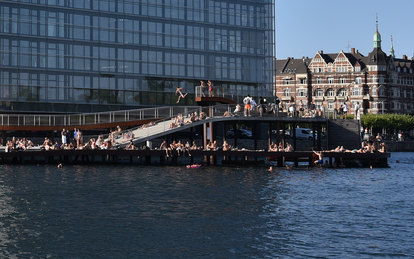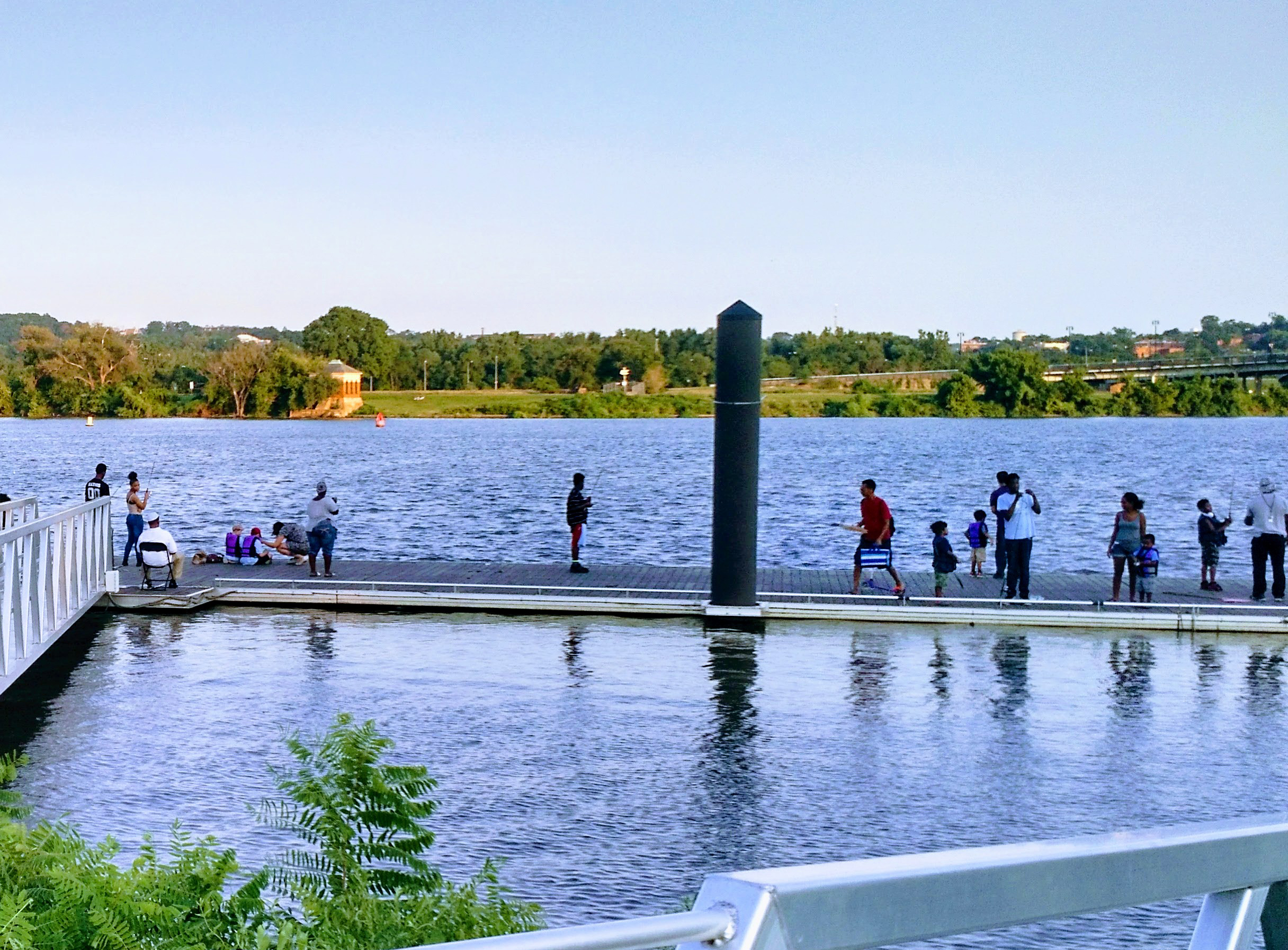Lessons in Danish Urbanism | Part 2: Urban Swimming in Copenhagen…and Washington DC

The Kalvebod Waves Harbour Bath in Copenhagen, Denmark (Photo credit: Merrill St. Leger)
Copenhagen’s Harbour Baths
In the summer of 2018, the Danish capital city of Copenhagen saw record temperatures as part of a heatwave that beset Europe that season. During the two weeks I spent there , temperatures were in the upper 80s (◦F) -- the average is typically 70 (◦F). Not only was July of 2018 the sunniest ever recorded in 98 years, and the rainfall, typically measuring two inches at that time of year, was next to nothing. Parched, yellow lawns were one visible sign of the heat and drought. The other more positive sign was the swimming, which Copenhagen was well prepared for.
In the last 16 years, Copenhagen has constructed four harbour baths, or facilities that allow people to swim directly in Copenhagen’s harbour waters. Following decades of clean-up efforts including rerouting wastewater, building overflow barriers, creating underground water-storage vessels, and daily water quality monitoring, Islands Brygge Harbour Bath opened and became an instant architectural icon. It was followed by Fisketorvet, the Kalvebod Waves and Sluseholmen. The four are within two miles of each other within a city of just over 600,000 inhabitants. Each harbour bath provides different swimming experiences including wading pools, general swim areas, and platforms from which to jump into the water. Even where there is no pool along the harbour, people set up towels to lounge on and take dips in the water, play kayak polo, or just sunbathe. The Danes have done wonderful things to make swimming fun and accessible in water that was previously polluted.
The harbour baths in Copenhagen are not just a wonderful way to spend a hot summer afternoon, they are a visible celebration of Denmark’s success in cleaning its waterways. More than a mere source of entertainment, they are a joyous way of connecting people of all ages and abilities to their urban waterfront. This phenomenon is not limited to Copenhagen. Paris, Zurich, among other major cities already have very successful harbour baths, while London, Melbourne, New York, Boston and others are in the process of planning theirs.
The Anacostia River Pool
In Washington, DC, there is a similar outlook on and a desire by residents to swim in our two rivers, the Potomac and the Anacostia. The District has recently embraced its two rivers as places for recreation, connection to nature, and economic development. Major new developments including the Wharf and the Yards Park have reinforced DC as a destination city with a vibrant waterfront. The 2014 PlayDC Vision Framework calls for increases in the number of pools and aquatic program offerings for all residents and identified adult and youth learn-to-swim as “top priority facilities or programs” for the District.
In 2018, as part of the Year of the Anacostia initiative, the Anacostia Waterfront Trust came up with a vision to create the Anacostia River Pool. We at SmithGroup jumped right in (pun intended!) to help. Working with the Trust, we developed a feasibility study which is the first step in making the Anacostia River Pool a reality.
The feasibility study describes how it is becoming safe to swim in the Anacostia and is, in fact, currently safe on many days, and legal for special events by permission. While years of pollution from combined sewer overflows, industrial waste and agricultural runoff had degraded this river, 2018 marked the opening of DC Water’s Anacostia River Tunnel. This 7.7 mile, 100-million gallon tunnel system collects and stores combined sewer overflows and conveys them to the Blue Plains Wastewater Treatment Plant before they enter the river. Between March and October 2018, with approximately 35 inches of rainfall, 3.34 billion gallons of Combined Sewer Overflows (CSOs) were captured and diverted -- an 89-percent capture rate compared to a goal of 80-percent. The completion of the Northeast Boundary Tunnel in 2023 will increase the storage capacity by an additional 90 million gallons and is projected to further reduce CSOs by 98-percent.
Meanwhile, the DC Department of Energy and Environment is concurrently conducting the Anacostia River Sediment Project, a remedial investigation and feasibility study to address polluted sediment at the bottom of the Anacostia. These initiatives, together with ongoing government and citizen monitoring of river conditions, will make it possible to swim in the Anacostia in the very near future.
SmithGroup’s feasibility study describes case studies from around the world and identifies design opportunities based on research into existing and planned pools and inspired by an internal SmithGroup firmwide design competition. The study also examines the feasibility of nine potential sites for the pool along the Anacostia River. This document will inform a future process that will engage nearby residents and potential users in envisioning the type of facility they want at a suitable location to best serve the community.
Correcting Swimming Inequities
While swimming is an increasingly popular activity in the District, it has also been subject to serious inequities over the years. The Anacostia River was often the only alternative for summertime swimming for African American children in the days of segregation, often with tragic consequences. The creation of a swimming pool in the river for all to use celebrates the joys of swimming for everyone and honors those who were directly affected by these inequities. In addition, there continues to be a low rate of self-reported ability to swim among African Americans. The river pool would be a new and exciting venue for swimming that could provide additional learn-to-swim opportunities in a unique setting. Although the Anacostia River has historically been something of a dividing line in the District, a river pool could further reinforce the steady transformation of the river into a connector and amenity shared by everyone in the District.
Just as the four harbour baths in Copenhagen celebrate the vibrancy of that great city and the pure delight of swimming on a hot summer day, the future Anacostia River Pool will be an active and visible sign of the Anacostia River’s restored health, and a celebration of the joy of swimming for all District residents.
